“The Life of Color ‐ Color as Cross-Media ‐ John Ruskin and Afterwards”
Yukiko KATO*
*Associate Professor, Saitama University, Saitama, Japan
*Visiting Researcher, Research Center for Ars Vivendi, Ritsumeikan University, Kyoto, Japan
1. Prospect of John Ruskin’s Radical Color Theory
Color is single, not as a lifeless thing and a rigid individuality but as a winged creature that flits from one form to the next. Children make soap bubbles. Similarly, games with painted sticks, sewing kits, decals, parlor games, even pull-out picture books, and to a lesser extent, making objects by folding paper-all involve this view of color. (Walter Benjamin. “A Child’s View of Color,” 1914-5.) [1]
British art critic John Ruskin, who had an enduring impact on his contemporary artists and intellectuals, was among the earliest critics to anticipate Walter Benjamin’s claim that color should be thought of as a living thing, not a mere pigment. Ruskin’s claim that a painter must commit his life to the practice of coloring-cited below from his The Elements of Drawing in 1857-indicates one of the core issues concerning the function of color at stake in the modern art world. Ruskin states:
You ought to love colour, and to think nothing quite beautiful or perfect without it; and if you really do love it, for its own sake, and are not merely desirous to colour because you think painting a finer thing than drawing, there is some chance you may colour well. […] You may, in the time which other vocations leave at your disposal, produce finished, beautiful, and masterly drawings in light and shade. But to colour well, requires your life. It can not be done cheaper. The difficulty of doing right is increased-not twofold nor threefold, but a thousandfold, and more-by the addition of colour to your work. […] the difficulty is strangely increased,-and multiplied almost to infinity by this great fact, that, which form is absolute, so that you can say at the moment you draw any line that it is either right or wrong, colour is wholly relative. […] so that every touch must be laid, not with a view to its effect at the time, but with a view to its effect in futurity, the result upon it of all that is afterwards to be done being previously considered. You may easily understand that, this being so, nothing but the devotion of life, and great genius besides, can make a colourist. [2] [emphasis in original]
This passionate statement warns painters or “colourists” to be prepared for the complexities that the process of coloring will present. Painters should have thorough comprehension and sufficient foresight to anticipate and embrace relativity, multiplicity, complexity, subtleness, and all aspects that accompany the application of color in creating a work of art. To fulfill this overwhelming duty, according to Ruskin, painters were to devote their lives to this process.
Although, or rather because, the word “life” in this context could be extremely multivalent, Ruskin’s argument illuminates a domain that transcended the conventional sphere of artistic practices during the nineteenth century, which included artists’ participation in salons, academies, exhibitions, political propaganda, and so forth. He directly addresses the broader realm of the artists’ personal maxim through the discourse of color, characterized by its transgressive nature. The “life” associated with the characteristics of color-mentioned above as noted by Ruskin-is a place that is relative, borderless, nebulous, and complex, that is always connected to something else. To be true “colourists,” painters ought to give their full consideration to all the possible aspects associated with color across the boundaries of art and “non”-art. Accordingly, various conventional distinctions-between art and life, perception and action, aesthetics and ethics, subject and object, reason and sensibility-are overcome in terms of the discourse of color. Such discourse transformed the aesthetics of color into that of coloring-in other words, aesthetic discourse became focused on the practice (or enacting) of color, as well as the end result.
I would like to call this transgressive nature of color “cross-media,” and call your attention to this special nature intrinsic to color. In fact, color experience infiltrates the boundaries of all fields of life that bridge the gap between perception and action. For instance, we can see typical examples in the history of action paintings [Figure 1 & 2]. Figure 1 is Jackson Pollock’s painting action, which was photographed by Hans Namuth in 1950. The performative act of coloring plays a critical role in this artwork, and color perception and coloring action are intermingled each other. Moreover, in this action, at least four senses, i.e. vision, touch, smell, and hearing (dripping sounds of paints and the brush) are involved. Figure 2, the notorious work by Yves Klein, called “Anthropometry Performance,” probably embraced even the fifth sense, “taste,” as the female performers must have been forced to taste the canvas and pigments. The important point here is that color as media affiliates with various different senses at once, much as Ruskin indicated when he stated that a painter dealing with color should devote his or her “life” to it.
This as-it-were multisensory nature of color can be confirmed in the phenomena of synesthesia, which began to catch people’s attention in mid-nineteenth century Europe through the works of psychologists including George Field (1835), Gustav Theodor Fechner (1876-1877), and Francis Galton (1883)[3]. These books largely focus on the phenomena called “color hearing” and “grapheme-color synesthesia.” “Color hearing” is a phenomenon in which a particular musical or spoken sound evokes a particular color. “Grapheme-color synesthesia” [Figure 3] is the sort in which a particular letter or number evokes a certain color. For example, Figure 3 shows a case in which one sees green with “S” and “4.” Purportedly, the French poet Arthur Rimbaud and the Russian composer Aleksandr Scriabin possessed this color-oriented synesthesia [4]. This claim is supported by their works, including as Rimbaud’s sonnet “Vowels” (1871)[5] and Scriabin’s “Prometheus: The Poem of Fire” (1910) [6]. Although I cannot delve into the details of these works now, I mention these facts to support the claim that color plays a fundamental role in bridging different senses.
The third example in which color bridges perception and action is the critical role that color plays in consumer society. As anthropologist David Howes points out, late capitalism is the age of “hyperesthesia,” in which people make full use of the five senses [7]. As we know, color infiltrates our shopping experiences everyday [Figure 4]. A large number of fashion brands such as “Franc Franc,” “Benetton,” and “UNIQLO,” sell their products by gradation of color. We see a variety of products, including furniture, clothes, cell phones, iPods, perfumes, and candies being offered according to color gradations. When we choose and shop for them, we look, touch, smell, hear, and sometimes taste them. Color always permeates such sensory experiences in consumer society.
Of course, color has always been with us, probably since the birth of our vision: however, I argue that the significance of color as “cross-media” has come to be even greater in modern and late modern age. This paper focuses on a point in history when the understanding of color may have started to embrace a field beyond mere visual perception-namely, Europe in the mid- and late nineteenth century, when Ruskin’s Element of Drawing was actually published.
2. Color “Crosses” Perception and Action: The Neo-Impressionist Case
Since this paper started with the passionate statement of John Ruskin, we have to check in on how the statement has actually evolves into the above-mentioned twentieth- and twenty-first-century situation where color has a connotation of multivalent life. Ruskin had an enduring impact on the artists now called “Neo-Impressionists,” whose technique is known for pointillism or dotted color dabs. One of the leading painters of the group, Paul Signac, designated Ruskin as “the greatest aesthetician of the century” [9]. I will quickly introduce the relationship between Ruskin’s aesthetics and Neo-Impressionist activities as a case study of the value of multivalent color. Although Ruskin’s impact on the Neo-Impressionist group must have been various to mention-which, for example, could be the initiation of pointillist technique and the synthesis of art and daily life-the transgressive nature of color experience that Ruskin emphasized above can surely be seen in the Neo-Impressionist understanding of color [10].
Georges Seurat-recognized as the founder of the Neo-Impressionist movement for his sensational large painting “Sunday Afternoon on the Island of Grande Jatte” of 1886-emphasized the importance of the viewer’s durational retinal activity stimulated by colored dots. In his “Letter to Maurice Beaubourg, August 28, 1890,” Seurat described how the viewer could respond to a Neo-Impressionist dotted work:
Given the phenomena of the duration of a light impression on the retina synthesis is the unavoidable result. The means of expression is the optical mixture of tonal values and colors (both local color and the color of the light source, be it sun, oil lamp, gas, etc.), that is to say, the optical mixture of lights and of their reactions (shadows) in accordance with the laws of contrast, gradation, and irradiation [11].
This text implies that the viewer’s durational perception was regarded as the key to appreciating the various effects of contrast, gradation, and irradiation that the dotted work offers. Without such a temporal experience, the work of art could not be fully synthesized as initially intended by the painter.
However, more significantly, this durational experience does not mean a simple extension of time in appreciation, but it brings about a fundamental topological shift of the place in which the artwork could function. Without the viewer’s mental activity, the work would not be complete. The critical place of work exists not only in the individual creation of the work of art itself but also in the viewer’s mental activity as we accomplish the work of perception. A boundary between perception and action blurs in this way of engagement, which establishes a new relation between the viewer and the painting. Importantly, it is color experience that bridges perception and action.
Arguably, Seurat’s proposed way of looking at a painting is indicative of his own way of painting. As previous studies have demonstrated, to complete one oil painting, Seurat habitually made a large number of studies. For example, it is well known that at least twenty-eight drawings, twenty-eight panels, and three canvases-variously focused and arranged-were created for the “Grande Jatte” from 1883 to 1885 [12] [Figure 5]. Since each sketch shows totally different figures piece by piece, one could argue that Seurat designed each figure independently like puzzle pieces to be assembled into the final work. In other words, “Grande Jatte” may be understood as a product of extensive interactions or communications between the painter and each individual figure over time, and does not attempt to embody a representation of a single frozen moment.
In fact, as is often pointed out, Seurat’s painting shows a strange spatial inconsistency in the depiction of figural groupings relative to each other, and this discrepancy causes a certain difficulty for viewers as they mentally synthesize multiple objects in the painting [13]. As a result of Seurat’s lengthy and fragmented working process, the viewer is led to communicate back and forth with each element of painting, and this lively manner of interaction has become itself a significant part of the work [14]. This also brings to mind the fact that Seurat priced his painting in a wage-like manner. When the Belgian critic Octave Maus asked the price of Seurat’s work “Poseuses” (1888) [Figure 6], the painter calculated it as being equivalent to a year’s salary at seven francs a day [15]. Painting action and appreciation or perception of a painting, in this way, were incorporated together into the wholeness of “life,” to use Ruskin’s term. Considering the Western history of art, this is totally different from the previous avant-gardists such as Realists and Impressionists who painted and represented “frozen” moment of life.
3. Color and Neuroscience: What Makes Color “Cross-Media”
Significant to this discussion are the questions: how were color temporality and viewers’ participation suddenly introduced into the world of painting, and what was the significance of their introduction? Among various factors [16], I will focus on the impact of neuro-psychological discourse. In order to examine the temporality and active perception associated with Neo-Impressionist painting, it is critical to analyze the critic Félix Fénéon’s earliest writings on Neo-Impressionism from 1886 to 1891, because they were among the first and most well propagated theoretical explanations of Neo-Impressionist color techniques, and it is Fénéon who christened the name of “néo-impressionnism” [17]. Regarding the temporality of perception, Fénéon’s analysis is more pointed and detailed than Seurat’s “Letter to Maurice Beaubourg” (1890). In “VIIIe Exposition Impressionniste” (1886), Fénéon analyzes the various durational color effects of Neo-Impressionist painting:
These color reactions, these sudden perceptions of complementaries, this Japanese vision, could not be expressed by means of shadowy sauces concocted on the palette: these painters thus made separate notations, letting the colors arise, vibrate in abrupt contacts, and recompose themselves at a distance. […] Messieurs Georges Seurat, Camille and Lucien Pissarro, Dubois-Pillet, and Paul Signac divide the tone in a conscious and scientific manner. This evolution dates from 1884, 1885, 1886. [18]
Here Fénéon recognizes the importance of the viewer’s mental activities-reaction, recomposition, and decompositions of vibrant colors-to the success of the Neo-Impressionists’ new approach to the use of color. Moreover, he perceives clearly how this suspended perception of color induces an active physical engagement with the work, requiring the viewer to move back (at a distance) and forth (in abrupt contacts) in front of the painting.
Although rarely pointed out, it is notable that Fénéon exclusively referred to the texts of the color theorist Ogden Rood and his associates, such as Hermann von Helmholtz, James Clark Maxwell, Wilhelm Dove, and Charles Henry, whereas the names of the chemist Eugene Chevreul and the art theorist Charles Blanc are strangely absent from his writing between 1886 and 1891. Significantly, Rood and his associates founded their research on a neuro-psychological explanation of color perception, while Chevreul and Blanc did not necessarily rely on that body of knowledge. [19] Ogden Rood, the most cited theorist in Fénéon’s writing, designates color generation as a function of the three optical nerves, i.e. RGB (red, green, and blue), following Thomas Young’s hypothesis. [20] On the basis of this neurological standardization of color vision, Rood believes that complementary afterimages are generated as a result of fatigue caused by the labor of the nerves. Rood connects afterimages with nervous system reactions that struggle for equilibrium among the three optical nerves:
According to our theory, the green light from the little square of paper, acting on the eye, fatigues to some extent the green nerves of the retina, the red and violet nerves meanwhile not being much affected. When the green paper is suddenly jerked away by the string, grey light is presented to the fatigued retina, and this grey light may be considered to consist, as far as we are concerned, of red, green, and violet light. […] The fatigue of the optic nerve, mentioned here does not differ essentially from that which it undergoes constantly, even under the conditions of ordinary use, where the waste is continually made good by the blood circulating in the retina, and by the little intervals of rest frequently occurring. [21]
Color mixture is no longer located physically in external objects, but optically within the retinal nervous function. The topological shift of color experience embraced by Neo-Impressionist aesthetics is most clearly realized here. Color vision is identified with the labor of the three nerves, and what is primarily measured in this experiment is not a ratio of pigments but that of the nervous labor.
Neuro-psychological discourse-which emerged gradually in the mid-eighteenth century, specifically along with Julien Offray de La Mettrie’s notion of the “man-machine”-came to designate the human being as a conglomeration of nerves. [22] This new understanding of human beings was based on an autonomic and circular model of the world, which departed radically from the traditional system of metaphysical philosophy and religion. In opposition to conventional religious authorities, La Mettrie in 1748 declared that “only by nature can we discover the meaning of the words of the Gospel,” and that “the excellence of reason does not depend on its immateriality, a big word empty of meaning.” [23] Machine discourse, which was largely based on the neuro-psychological notion of the human organism, refuted the Cartesian dichotomy of matter and mind with its monistic worldview. As the cultural historian Allison Muri points out:
The immaterial and immortal soul-which long proceeded Descartes-remained a tradition in metaphysical or literary discourses, but in terms of physiology and medical sciences it receded in relevance. The medical and technological intervention in the workings of human bodies that creates cyborgs is not a legacy of Cartesian dualism, but an emphatically monistic one where human identity is profoundly physical and embodied. [24]
A characteristic feature of the neuro-psychological model for the human organism is its closed and circular system. William James drew a scheme in 1890 that typically describes a nerve system in which sensory and motor nerves are continuous and homogeneous in quality [Figure 7]. Once a sensory organ captures a certain stimulus, the nerve transmits it as a signal, and the motor nerve moves the muscle according to that signal. This transmission system does not require any external reason and power, for nerve communication is a completely circular and autonomous system. This understanding of the human organism rejects metaphysical social conventions, as Christoph Asendorf demonstrates, and can only be compared with the capitalistic economic system, which is governed by a monistic monetary circulation [25]. The neuro-psychological understanding of color goes along with this monistic worldview. These monistic but still multivalent features of life are strangely consistent with Ruskin’s idea of color and life. It is important that both discourses happened to grow from the nineteenth-century on.
Neo-Impressionist and its neuro-psychological discourse of color are part of such onset of multivalent life of color. However, as I mentioned at the beginning of this article, the history of art and consumer society prove the existence of multivalent life of color. The twentieth century philosopher Emanuel Levinas stated that “one does not conceive the sensible qualities, but one lives these qualities: green of these leaves, and red of this sun-set” [26]. In short, we do not perceive but live colors. Once we have overcome the conventional dichotomy between subject and object, the holistic worldview is prepared in front of us. Is this mere monistic tautology or real enrichment of life? This is a fitting question for us who live in the society of late capitalism and hyperaesthesia. Although it is impossible to give a single answer to this question, at least we can confirm that we are living in such a monolithic world that annuls various dichotomies as well as embraces multifarious senses. Color definitely plays a critical role in such a new world.
- Figure 1
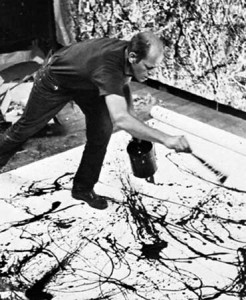
Jackson Pollock, photographed by Hans Namuth, 1950 (Copyright is owned by the Hans Namuth Estate). - Figure 2
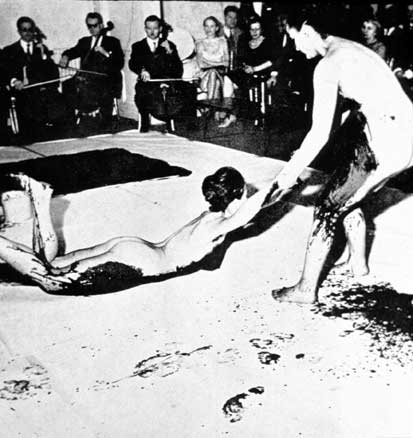
Yves Klein, “Anthropometry Performance,” Mar 9, 1960. - (From http://zeynepkinli.wordpress.com/2009/05/15/825/)
- Figure 3
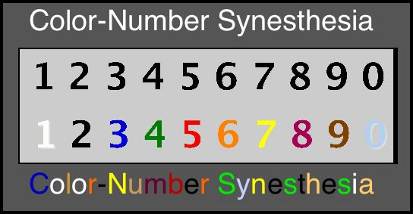
Grapheme-color synesthesia - (Source: http://blog.lib.umn.edu/nich0185/myblog/2011/10/synesthesia.html
- [the blog for the Fall 2011 offering of PSY1001, Section 23])
- Figure 4

FrancFranc Shop, Sendai, Japan - (from http://sendai.keizai.biz/headline/347/)
- Figure 5
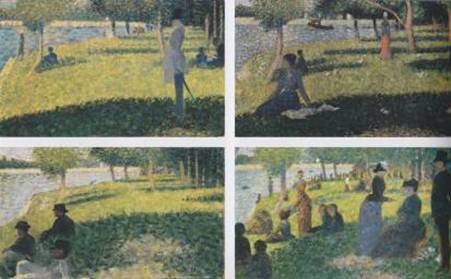
Georges Seurat: Four sketches of “La Grande Jatte”1884 as shown in Robert L. Herbert. Seurat and the Making of La Grande Jatte, Exhibit. Cat. The Art Institute of Chicago, 2004; p. 74. - Figure 6
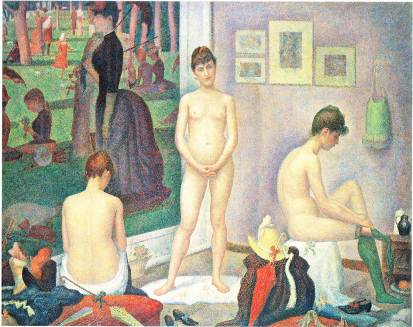
Georges Seurat. “Poseuses,” 1887-88, oil and gesso on canvas, 200 x 250 cm, The Barnes Foundation, Merion, Pennsylvania - Figure 7
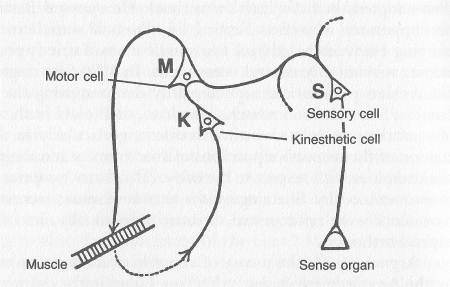
Idealized diagram of reflex organization of reflex organization of movement according to William James from Marc Jeannerod. The Brain Machine: The Development of Neurophysiological Thought, trans. David Urion, Harvard University Press, 1985; p. 94.
References
- [1] Walter Benjamin. Selected Writings, vol. 1, 1913-1926, ed. Marcus Bullock and Michael W. Jennings, Cambridge: The Belknap Press, 1996; pp. 50-51.
- [2] John Ruskin. The Elements of Drawing, Boston and New York: Colonial Press Company, 1909 (1857), Section 152; pp. 133-134.
- [3]George Field, Chromotography (1835); Gustave Theodor Fechner. Vorschule der Ästhetic (1876-1877); Francis Galton, Inquiries into Human Faculty and its Development (1883).
- [4]John Gage. “Synesthesia,” Encyclopedia of Aesthetics, vol. 4, Oxford University Press, 1998, pp.348-351.
- [5]Voyelles: “A noir, E blanc, I rouge, U vert, O bleu, …”
- [6] In the public performance in New York in 1915, color lights were projected simultaneously with sounds of the keyboards.
- [7] David Howes. “Hyperesthesia, or, the Sensual Logic of Late Capitalism,” David Howes (ed.), Empire of the Senses, Oxford: Berg, 2004, pp. 281-302.
- [8] As I am art historian majoring in 19th and 20th century European art, I will limit the topic to European history. However, there must have been a number of significant points concerning the multisensory aesthetics of color if we do not limit the topic.
- [9] Paul Signac. “Le néo-impressionnisme” 1898: in Erich Franz, ed. Signac et la liberation de la couleur: de Matisse à Mondrian, Paris: Réunion des musées nationaux, 1997; p. 382; see note 1 as well.
- [10] Although the full text of Ruskin’s The Elements of Drawing (1857), was not translated into French in the nineteenth century, his theories were well known to French painters by virtue of their translation in Ogden Rood’s Modern Chromatics (French translation: 1881), Octave Maus’s journal L’art moderne (Novembre 11, 1888 [8th year no. 46]; p. 365f.), and Robert de La Sizeranne’s articles in La Revue des deux mondes (“La Religion de la beauté: Etude sur John Ruskin,” pts 3 & 4: “Sa pensée,” La Revue des deux mondes, 139, February 1st, 1897; pp. 610-633; La Revue des deux mondes, 140, March 1st, 1897; pp. 169-203). Rood and Signac in their major works, cited various key phrases from Ruskin’s text (1857), specifically in relation to pointillism (Ogden Rood. Modern Chromatics, New York, 1879; Chapter X; Paul Signac. D’Eugène Delacroix au néo-impressionnisme, Paris: Hermann, 1964 (1899); p. 116f.). Robyn Roslak also deals with Ruskin’s influence on Neo-Impressionism in her latest work (Robyn S. Roslak. Neo-Impressionism and Anarchism in Fin-de-Siècle France: Painting, Politics and Landscape, Ashgate, 2007; p. 186f).
- [11] Georges Seurat. “From a Letter to Maurice Beaubourg (1890),” in Norma Broude, ed. Seurat in Perspective, The Artist in Perspective Series, Prentice-Hall, 1978; 19. Original French text, “Brouillon de lettre à Maurice Beaubourg 28 août 1890” is in Georges Seurat et al. Seurat: Correspondances, témoignages, notes inédites, critiques, ed. Hélène Seyrès, Paris: Acropole, 1991; p. 252.
- [12] Robert L. Herbert. Seurat and the Making of La Grande Jatte, Exhibit. Cat. The Art Institute of Chicago, 2004; p. 68. For the grid system which Seurat used in order to assemble various “parts” of his studies, see Paul Smith. Seurat and the Avant-Garde, Yale University Press, 1997; pp. 19-21; Frank Zuccari and Allison Langley, “Seurat’s Working Process: The Compositional Evolution of La Grande Jatte,” Herbert 2004; 179f.
- [13] For example, see Michael F. Zimmermann. “Seurat, Charles Blanc, and naturalist art criticism,” Museum Studies, vol. 14, no.2, 1989, note 46, and his discussion on Ephraim Mikhael’s poem “The Toy Shop” (1890). Donald Kuspit. “The Anal Universe of the Crowd,” Psychostrategies of Avant-Garde Art, Cambridge University Press, 2000; pp. 86-121.
- [14] Prudence Jo Nater. Modern art and time: the role of the time concept in the paintings of selected late nineteenth and early twentieth century art movements, Masters Thesis, San Francisco State College, San Francisco, California, 1969; p. 11.
- [15] Georges Seurat. “Letter to Octave Maus, February 17, 1889” in Octave Maus. Trente années de lutte pour l’art, 1884-1914, Brussels, 1926; p. 87: “Quant à mes Poseuses, je suis très embarrassé pour en fixer le prix. Je compte, comme frais, une année à 7 francs par jour: ainsi voyez où cela me mène. Pour me résumer, je vous dirai que la personnalité de l’amateur peut me payer la différence de son prix au mien.”
- [16] Answers are multiple: it may have been a conservative tendency counter to the Impressionists’ supposed hasty improvisations; or perhaps it is indicative of the Neo-Impressionists’ interest in Symbolist theater, which could account for some compositional devices; or the influence of the newly emerged color-print technique, which went through multiple processes to finish one print, and so forth.
- [17] Right after the eighth Impressionist exhibition in 1886 where Seurat first exhibited the “Grande Jatte,” Fénéon published his review of the show entitled “VIIIe Exposition Impressionniste” in his own journal La Vogue in June and July 1886. In this article, Fénéon identified a different color technique as characterizing the art of the “new” Impressionists, including Seurat, Camille and Lucien Pissarro, Dubois-Pillet, and Signac. Fénéon later reprinted a slightly revised version of the article under the title of “Les Impressionnistes en 1886” in October 1886. Between the two articles, he also published a significant theoretical analysis of the new color technique under the title of “L’Impressionnisme aux Tuileries” in September 1886. These three articles in 1886 laid a foundation for the theoretical analysis of Neo-Impressionist aesthetics, which appeared only a few months after the “Grande Jatte” exhibition. From then on, Fénéon periodically published a number of reviews associated with Neo-Impressionism, making his the dominant critical voice among the supporters of Neo-Impressionist aesthetics: “L’Impressionnisme” (April 1887), “Le néo-impressionnisme” (May 1887), “Le néo-impressionnisme” (1888), and “Signac” (1890) to name a few.
- [18] Felix Fénéon. “From the Impressionists in 1886 (1886),” in Broude 1978, pp. 36-37. Original text is reprinted in Felix Fénéon. Oeuvres plus que complètes, Geneva: Librairie Droz, 1970, p. 35.
- [19] Fénéon. “From the Impressionists in 1886 (1886),” in Broude 1978; pp. 37-38. Fénéon’s choice clearly suggests his firm belief in neuro-psychological science. Again in “VIIIe Exposition Impressionniste” (1886), Fénéon exclusively refers to Rood’s text to claim the necessity of optical mixture in painting:These colors, isolated on the canvas, recombine on the retina: we have, therefore, not a mixture of material colors (pigments), but a mixture of differently colored rays of light. Need we recall that even when the colors are the same, mixed pigments and mixed rays of light do not necessarily produce the same results? It is also generally understood that the luminosity of optical mixtures is always superior to that of material mixture, as the many equations worked out by M. Rood show. For a violet-carmine and a Prussian blue, from which a gray-blue results:50 carmine + 50 blue = 47 carmine + 49 blue +4 black
(mixture of pigments) (mixture of rays of light)For carmine and green:
50 carmine + 50 green =50 carmine + 24 green + 26 blackWe can understand why the Impressionists, in striving to express extreme luminosities-as did Delacroix before them-wish to substitute optical mixture for mixing on the palette. Monsieur Seurat is the first to present a complete and systematic paradigm of this new technique.In this passage, which persuades painters to avoid pigmental mixture on the palette, Fénéon refers to the tenth chapter of Rood’s Modern Chromatics, which explains the difference between mixtures of pigments and colored light based on quantified equations like the ones cited above. - [20] Thomas Young originally designated the three primary colors as orange, green, and violet, instead of red, green, blue.
- [21] Rood 1879; p. 237.
- [22] Julien Offray de La Mettrie was inspired by William Harvey’s explanations of the heart and circulatory system as pump and tubing, by Jacques de Vaucanson’s mechanical duck and mechanical flute player, and by Albrecht Haller’s work on muscular irritability, among others. (Julien Offray de La Mettrie. Man a Machine/ Man a Plant, translated by Richard A. Watson and Maya Rybalka, Indianapolis & Cambridge: Hackett Publishing Company, 1994 (1748): pp. 1-27; 59f.)
- [23] La Mettrie. Ibid.; pp. 27-28. According to Marc Jeannerod, La Mettrie’s notion of man-machine is the first materialistic explanation of the soul (Marc Jeannerod. The Brain Machine, trans. David Urion, Harvard University Press, 1985; pp. 8-11.)
- [24] Allison Muri. The Enlightenment Cyborg: A History of Communications and Control in the Human Machine, 1660-1830, University of Toronto Press, 2007; p. 28.
- [25] Christoph Asendorf. Batteries of Life: On the History of Things and Their Perception in Modernity, trans. from German by Don Reneau, University of California Press, 1993; pp. 7-10.
- [26] Emmanuel Levinas. Totalite et Infini, martinus Nijihoff, 1971 (1961), p.143: “On ne connaît pas, on vit les qualities sensibles: le vert de ces feuilles, le rouge de ce couchant.” (emphasis-YK)
*This study is supported by Grant-in-Aid for Research Activity Start-up (23820070)











